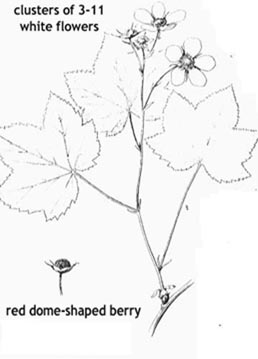
General Species Description
- Rubus parviflorus is an erect shrub usually 0.5-2.5 meters tall from branching rhizomes. It forms dense thickets and is unarmed. Leaves are broad, palmately lobed and fuzzy.
Leaves
- The deciduous leaves are alternate, large (up to 25 cm across) and light green. They commonly have five pointed lobes (maple-like) are marginally toothed and have fine velvety textures on both sides.
Inflorescence/Flowers
- The flowers are large (up to 4 cm across) and have white petals that appear crinkled. Three to eleven long stemmed flowers grow in loose, terminal clusters. They bloom June and July.
Fruits
- Fruits are bright red when ripe, after turning from green to white to pink. They are shallowly cupped and are seedy, like raspberries. The taste varies with weather and locality, but can be sweet.
Habitat
- Rubus parviflorus is found in open to moist dry sites. In Oregon, it is commonly found along roadsides, edges of forests, shorelines, and logged slopes. Associated species include Alnus rubra (red alder), and sambucus racemosa (red alderberry).
Range
- Sea level to subalpine mountain slopes, from Alaska to southern California, east to the Great Lakes region. It is found in low elevations in the north, and in low to subalpine elevations in the south.
Similar Species
- The large, bright, fuzzy leaves are easily distinguishable, but similar species include the bark of Rubus spectabilis (salmonberry), which is more shiny and has young stems with prickles, bearing smaller and pinnately compound leaves and orange-yellow or red fruits. The similar bark of Amelanchier alnifolia (western serviceberry) is distinguished by simple leaves with round, toothed tips and fruits that are blueberry-shaped, reddish brown or dark purple. Physocarpus capitatus (pacific ninebark) has brown shedding bark, but has much smaller leaves, and woody capsule-like fruits.
Ecological Value
- Fruits are eaten by many species of wildlife from birds to large mammals. Leaves and twigs are grazed by browsers. The dense thicket provides protection and nesting sites.
Human Value
- Fruits are gathered and eaten by humans. Berries are easily dried and the Nuu-chah-nulth made special dried berry cakes with smoked clams which could be stored. Coastal aboriginal groups ate the raw and peeled young sprouts as green vegetables after gathering in early spring to early summer. They have a sweet an juicy taste. The velvety leaves may also be an excellent woodland tissue paper.
References
- Cooke, Sarah Spear. A Field Guide to the Common Wetland Plants of Western Washington and Northwestern Oregon. Seattle: Seattle Audobon Society, 1997. Pojar, Jim and Andy MacKinnon. Plants of the Pacific Northwest Coast: Washington, Oregon, British Columbia and Alaska. Vancouver, British Columbia: Lone Pine Publishing, 1994. Turner, Nancy. Food Plants of Coastal First Peoples. Vancouver, British Columbia: UBC Press, 1995.
This page was created by: Wendy Walters, August 1998
Return to Northwest Oregon Wetland Plants Project